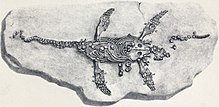Eretmosaurus
| Eretmosaurus Temporal range: Early Jurassic,
| |
|---|---|

| |
| Neotype specimen of E. rugosus | |
| Scientific classification | |
| Domain: | Eukaryota |
| Kingdom: | Animalia |
| Phylum: | Chordata |
| Class: | Reptilia |
| Superorder: | †Sauropterygia |
| Order: | †Plesiosauria |
| Family: | †Microcleididae |
| Genus: | †Eretmosaurus Seeley, 1874 |
| Type species | |
| †Eretmosaurus rugosus Seeley, 1874
| |
| Synonyms | |
| |
Eretmosaurus is an extinct genus of plesiosaur from the Early Jurassic Blue Lias of England.[1] Only the type species is known, which is E. rugosus.[2]
History


The syntypes consisted of several vertebrae that had been discovered at different locations in the Blue Lias in Gloucestershire. Owen (1840) was the first to describe the specimens, which were named as Plesiosaurus rugosus.[3]
Later, Owen (1865) described a headless skeleton discovered in the Ammonites stellaris zone of the Blue Lias at Granby, Nottinghamshire (NHMUK 14435) that he assigned to P. rugosus,[4] and Seeley used NHMUK 14435 as the basis for naming Eretmosaurus rugosus in 1874.[2]
As the original vertebrae were not diagnostic and all lost by 1940, a petition was filed with the ICZN over the holotype by Brown and Bardet (1994),[1] and NHMUK 14435 was allocated as the official neotype in 1996.[5]
Benton and Spencer (1995) mentioned a second species of Eretmosaurus: E. macropterus; they rectified this mistake within the same paper by mentioning on page 116 that E. macropterus actually belongs to Microcleidus.[6]
Classification
Eretmosaurus was classified into Rhomaleosauridae by Persson (1963),[7] then into Pliosauridae by Brown (1981),[8] then into Elasmosauridae by Bardet (1995)[9] and Bardet et al. (1999),[10] and most recently into Microcleididae by Benson et al. (2012).[11]
See also
- List of plesiosaur genera
- Timeline of plesiosaur research
- Jurassic plesiosaurs of Europe
- List of plesiosaurs
References
- ^ a b David S. Brown and Nathalie Bardet (1994). Plesiosaurus rugosus Owen, 1840 (currently Eretmosaurus rugosus, Reptilia, Plesiosauria) proposed designation of a neotype. Bulletin of Zoological Nomenclature 51(3)
- ^ a b Seeley, H. G., (1874), Note on some of the generic modifications of the plesiosaurian pectoral arch: Quarterly Journal of the Geological Society of London, 1874, p. 436-449.
- ^ R. Owen. (1840). Report on British fossil reptiles. Report of the Ninth Meeting of the British Association for the Advancement of Science, Reports on the State of Science 43-126
- ^ R. Owen. (1865). A monograph of the fossil Reptilia of the Liassic formations. Part I, Sauropterygia. Palaeontographical Society Monographs 17(75):1-40
- ^ David S. Bown and Nathalie Bardet (1996). Plesiosaurus rugosus Owen, 1840 (currently Eretmosaurus rugosus, Reptilia, Plesiosauria) neotype designated. Bulletin of Zoological Nomenclature 51(3)
- ^ Benton, M. J. and Spencer, P. S. (1995). Fossil reptiles of Great Britain. Chapman and Hall, London, 386 pp.
- ^ Persson, P.O. (1963): A revision of the classification of the Plesiosauria, with a synopsis of the stratigraphical and geographical distribution of the group. University of Lunds Årsskrift 59, No. 1, p. 1-57.
- ^ Brown, D. S. (1981). The English Upper Jurassic Plesiosauroidea (Reptilia) and a review of the phylogeny and classification of the Plesiosauria. Bulletin of the British Museum (Natural History): Geology, 35, (4), 253-347.
- ^ Bardet, N. (1995). Evolution et extinction des reptiles marins au cours du Mésozoïque. Palaeovertebrata, 24, 177-283.
- ^ Bardet, N.; Godefroit, P.; and Sciau, J. (1999). A new elasmosaurid plesiosaur from the Lower Jurassic of Southern France. Palaeontology'", 42, (5), 927-952.
- ^ Benson, Roger B. J.; Evans, Mark; Druckenmiller, Patrick S. (2012-03-16). Lalueza-Fox, Carles (ed.). "High Diversity, Low Disparity and Small Body Size in Plesiosaurs (Reptilia, Sauropterygia) from the Triassic–Jurassic Boundary". PLOS ONE. 7 (3): e31838. Bibcode:2012PLoSO...731838B. doi:10.1371/journal.pone.0031838. ISSN 1932-6203. PMC 3306369. PMID 22438869.







